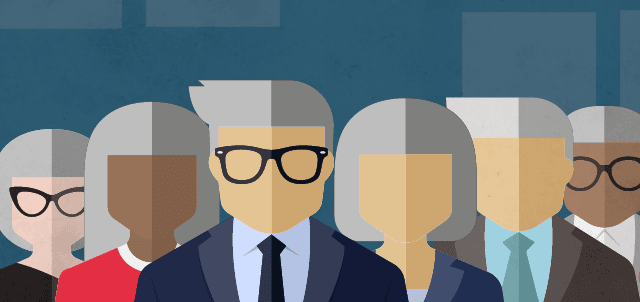Is your business ready for an aging workforce?
It’s estimated that by 2020, one-quarter of America’s workforce will be 55 years old and over, according to a Stanford research study .
And it’s not necessarily a money issue. In a recent CareerBuilder survey , one third of workers who are 60 years old and over admitted they enjoy their job too much to quit.
And with an army of millennials on-deck, employers are just years away from what could be a wide gap of age, talent and experience.
But with the right preparation, you can use this to your advantage. Here’s how to realign your workforce and recruiting strategies to meet the demands of this aging workforce.
Create an exit strategy for older employees
What do you do with an aging workforce who can see retirement on the horizon, but aren’t ready to call it quits?
In these cases, phased retirement plans may be the solution. This type of program allows your employees to gradually reduce their work hours over time.
For example, employees who regularly work around 40 hours a week could have their hours slowly reduced over a few years to an eventual part-time role.
This can also benefit a company if the employee is a top performer . A slow transition allows you to prepare a replacement without the shock that comes with a sudden retirement .
Flextime scheduling
Whether you’re developing an exit-strategy plan for your aging workforce or looking to adopt a more convenient schedule for each employee, a flextime schedule may be your answer.
As people grow older, they generally want to spend more time with family, take on hobbies, or simply relax. Keep this in mind as you begin to construct your employees’ exit-strategies, and see what you can do to work around their needs.
When you provide a flexible schedule, it can also help with absenteeism, retention and overall job satisfaction. It becomes a valued incentive to employees.
It also provides you an opportunity to negotiate on all fronts. Employees might be willing to take less pay for more flexibility in their schedule.
Treat everyone equally
If there’s one lesson you can take away from this, it’s that you should take age out of the equation.
In 2014, the U.S. Equal Employment Opportunity Commission recorded 20,558 complaints of age discrimination , up nearly 30 percent from 2000. This means it’s as important as ever for employers not to offend anyone when it comes to age.
And with the introduction of the Affordable Care Act , some employers are concerned about the risk of rising health care costs, and how their aging workforce might contribute to the increase.
It’s common for employers to think that employing older employees will cause premiums to skyrocket because they have more ailments.
But between texting-induced carpal tunnel syndrome and relaxed work environments, younger generations have become just as demanding and costly for perks and benefits .
This also opens a door to hiring issues. Older people are sometimes overlooked because it might be seen as a waste of time to grow or hire someone who could be retiring soon anyway. But when it comes to individual development, you should strive to see that each employee gets the attention and tools needed to succeed.
In any case, be careful in your decision-making and ensure you’re treating employees equally.
Younger doesn’t mean more productive
Although many young and agile employees may be bursting with talent, there are shortfalls you can come to expect from this demographic that you won’t typically find in older generations.
For example, younger employees are more likely to become distracted. They may check their social media regularly, blend fun throughout the day and prefer to work with friends.
When it comes to hiring for a position, you should focus on competency and talent.
You’ll find that in most cases, older generations are more focused, productive, and packed with wisdom. Just because your employees are getting older doesn’t mean they’re getting slower.
If you’re looking to include more of an older demographic in your recruiting search, take advantage of career websites that cater to this crowd. Indeed.com and AARP offer great resources for employers and senior employees.
Find positions that fit their skill set
Part of leading your business is making the most of the talent under your nose. And you’ll find that for some people, age may lessen certain skills while broadening other traits.
One common misconception is that older generations have struggled to cross the digital divide. But that couldn’t be further from the truth. These people have steadily adapted to more than meet the increasing demands of technology.
Some older employees may be less capable of serving in physically-demanding positions as they age. But that doesn’t make them less valuable. Evaluate their skill set. They may still be excellent performers in less physical positions.
Develop your workforce
When considering appropriate positions and exit strategies for your aging workforce, part of that could include helping employees develop skills for less-physical roles in your company.
Face-to-face, instructor-led training is hard to beat, but can be costly. With today’s technology, it doesn’t take much to launch an inexpensive online training platform, webcasts, how-to guides or other innovative learning methods.
A great way to spread knowledge is through a two-way mentoring program. Pair-up your older and younger employees, and encourage them to communicate or work together on projects. This allows both employees to share their knowledge and experience. It will benefit the whole company and shouldn’t affect your budget.
Regardless of age, you should make it a priority to grow the knowledge and experience of your workforce.
It doesn’t matter how old your employees are. They’re still your business’s most valuable asset.
Get your free guide, How to develop a top-notch workforce that will accelerate your business, to learn how to build a strong HR strategy that aligns your people with your company’s goals so your business has a clear-cut path to success.


